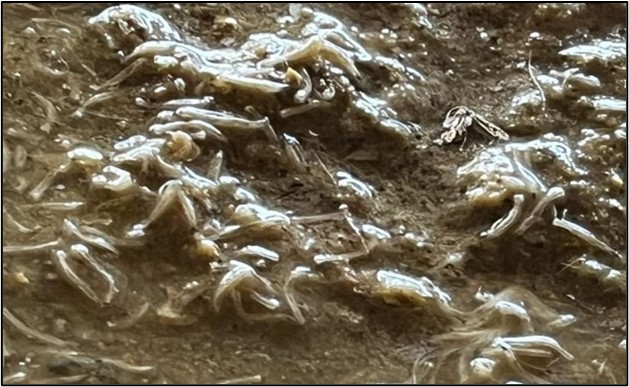Control of House Flies in Poultry Houses with Larvicides

CONTROLLING FLIES IN CAGED POULTRY HOUSES AND ROLE OF LARVICIDES
Dr. Rahul Mogale (Product Manager- Nutrition),
Dr. Sanjay Singhal (Chief Operating Officer)
Stallen South Asia Pvt Ltd. Mumbai
Fly nuisance is a very common problem in all type of poultry operations in India majorly in caged housing systems such as poultry layer and breeder farms. The layer farms located near to the human localities are always under the immense pressure to control the fly population as it leads on several occasions to shut down these farms due to complaints in municipalities about fly infestations. Large fly populations on poultry farms also leads to stress, discomfort and lower productivity in pullets, egg laying chickens and breeders. Also, these flies present an imminent danger in terms of diseases transmission in livestock and humans. It is essential to prevent and control the fly population for successful rearing and production of poultry birds.

Life cycle of flies
Flies go through unique sequential life stages to complete their life cycle: egg, larva (maggot), pupa, and adult fly (Fig.2). The life cycle of fly can vary between week to one month. In rotting, decaying, or fermenting organic stuff (such as waste, manure, etc.) with a moisture content of between 50 and 85%, flies breed and lay their eggs. Fresh poultry litter is particularly favourable as a medium for the development of fly populations because it contains a moisture level of about 75–80%

Negative impacts of fly population on poultry farms
- Increased discomfort and stress to poultry birds.
- Reduced production in poultry birds.
- Spreading diseases to livestock and humans.
- Community disturbance.
- Economic impact.
Did You Know?
One adult fly can lay upto 500 eggs.
Different strategies to control flies on poultry farm
The key to avoiding fly infestations is managing water and moisture in the litter. Farms that keep dry litter rarely experience serious fly infestations. A successful fly control program ensures moisture is controlled within the house and fly breeding sites are eliminated. One can adapt an effective fly control program by scheduling the weekly cleaning and maintenance tasks along with identifying potential fly breeding sites on your farms. Some potential fly breeding sites on poultry farms are as below:
- Accumulated faeces beneath laying hens in cages.
- Manure build-up beneath slats in breeder laying hen houses.
- Manure leftovers from scrapers and flushing systems.
- Wet litter under waterers in cage and broiler houses
- Feed and moist spilled feed.
- Dead birds and broken eggs in poultry houses.
Tips to control fly nuisance on poultry farms
Different strategies need to be followed to control the fly nuisance depending upon the seriousness of the issue on the site.
- Regular cleaning of farm and monitoring of potential farm breeding sites.
- Reducing the moisture of manure and litter by proper ventilation and spreading manure into thin layers.
- Removing manure twice weekly to break the fly breeding cycle.
- In systems with accumulated manure, remove only once or twice per year during the cool season and leave a base of dry, absorptive old manure.
- Fix the leaky waterers/nipples.
- Prevent feed spillage.
- Incinerate or compost dead birds immediately.
- Timely remove broken eggs from poultry house.
- Spray insecticides to control adult flies in and around poultry houses.
- Application of larvicides in fly breeding areas.
- Use insecticide paints, fly traps, sticky traps electric fly zappers etc.
Larvicides
Larvicides are a group of insecticides that are specifically known to control the larval stages of insects. Larvicides impair the nervous system of the fly larvae and cause mortalities. The market offers a variety of larvicidal products, which include chemicals and herbal products, spray products, feed-grade products, and liquid and powder-form products.
In IPM (Integrated Pest Management), the question of whether to use larvicides, adulticides, or both to control flies is often discussed. We suggest using both larvicides and adulticides for effective fly control. The reason behind is that although adult flies present more threat in terms on disease spread and nuisance, but we cannot neglect the fact that these adult
Fly larvae contribute about over 80% of whole fly population. Hence, it’s important to add larvicide to our effective fly control programme.
flies come from the larvae. Additionally, flies in the larval stage make up around 80-90% of the population in the environment in terms of quantity means individuals per unit area (see Catanguni, 2017: larvicide or not: is that the question, Poultry outlook– summer 2017).
In order to lower the overall population of house flies more effectively in poultry houses that produce eggs, we recommend increasing the usage of effective herbal larvicide products like Stallen’s Larvafix (an effective herbal insect growth regulator developed with local herbs, i.e., mint and Vidaalprnaas). The larvicidal activity of the mint family is associated with menthone and menthol, the major constituents present in these herbal plants (Kumar et al., 2011). and the larvicidal activity of Vidaalprnaas (N. cataria) is associated with the contents of 1,8-cineol, camphor, 4aa, 7a, 7ab-Nepetalactone, 4aa, 7b, 7aa-Nepetalactone, and thymol (Yang et al., 2020). The insecticidal mode of action of herbal plant extracts like mint and catnip (vidaalprnaas) has only been hypothesised as active ingredients exerting their effects on insects through neurotoxic activities involving several pathways, notably γ -amino-butyric acid (GABA), octopamine synapses, and the inhibition of acetylcholinesterase (Corbett, 1974).
Again, another question came to light: why should we use herbal larvicides over chemical larvicides? The simple answer to that question is that chemical sprays and insecticides have a history of losing their potency over time, but they also lead to disadvantages such as harmful side effects for humans and the environment. But in the case of herbal products, pests are less likely to build resistance since they are naturally derived rather than chemically produced, and they are also safe for humans and the environment.
LARVAFIX is Stallen’s herbal insect growth regulator developed with local herbs, i.e., mint and vidaalprnaas, for effective fly control on your poultry farms. Its effectiveness is tested in successful field trials.
Larvafix field trial
To see the effects of Larvafix, we successfully conducted a few field trials on caged layer farms in different parts of India that had trouble with large fly populations. We sprayed Larvafix at the recommended dose rate on poultry litter contaminated with a large number of fly larvae and observed the larvae and litter conditions for 4 consecutive days. Mortalities in larvae are observed within 48 hours, and drying off wet litter is noticed between days 3-5 (which varies depending on the challenge at the farms). You can see the difference between live larvae and wet litter before and after the Larvafix treatment in figs. 3 and 4.


Conclusion
Fly may seem like a little annoyance, but it plays an important role in transmitting disease to livestock and humans also leads to community disturbances. Flies can cause stress and discomfort to birds, leading to reduced egg protection or a lower meat yield. Regular monitoring and effective fly control strategies will help to maintain happy, healthy, and productive birds and improved public relations. It is estimated that 80-90% of house fly population in the environment is contributed by larval stages. Hence the effective fly control program must have an effective larvicide included in it.
ACK: the author duly acknowledges Google references sand illustrations




